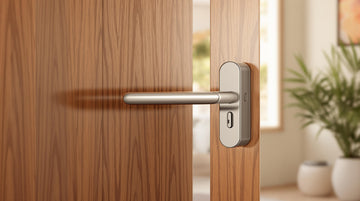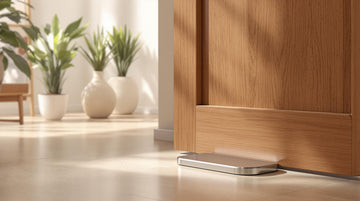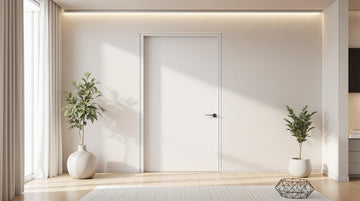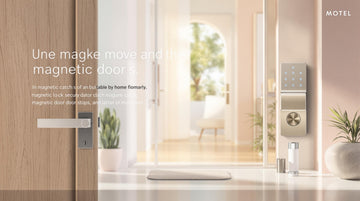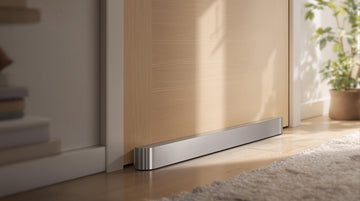
Door stoppers protect doors, walls, and surfaces from damage while keeping your space safe and functional. The right choice depends on your door type, room use, and preferences. Here's a quick breakdown:
- Types: Spring stops, floor-mounted, hinge-pin, wedge, and wall-mounted options.
- Materials: Stainless steel for durability, rubber for impact absorption, and silicone for glass doors.
-
Key Factors:
- Match stopper type to door weight and material.
- Measure door-to-floor gap for proper fit.
- Consider safety and style for specific rooms.
Quick Comparison Table
| Door Stopper Type | Best For | Key Features |
|---|---|---|
| Spring Stops | High-traffic areas | Absorbs impact, versatile use |
| Floor-mounted Stops | Heavy doors | Stable, durable |
| Hinge-pin Stops | Minimalist look | Space-saving, discreet |
| Wedge Stops | Temporary needs | Portable, no installation |
| Wall-mounted Stops | Limited floor space | Keeps floors clear, sturdy |
Start by evaluating your door’s needs, choose a material that lasts, and pick a style that complements your space.
Key Factors to Consider Before Choosing a Door Stopper
Evaluating Door Type and Swing
The type of door and the material it's made from play a big role in choosing the right stopper. Interior doors, exterior doors, glass doors, and heavy metal doors all have different needs. For instance, glass doors need soft, non-abrasive stoppers, while sturdy metal doors require options that can handle frequent impacts.
Measuring the Gap Between Door and Floor
After identifying your door type, it's essential to check the gap between the door and the floor. This measurement ensures the stopper will fit properly and work as intended. Grab a tape measure and note the distance from the bottom edge of the door to the floor.
| Gap Range | Suggested Stopper Type |
|---|---|
| 5-21mm | Magnetic door stoppers |
| 22-35mm | Floor-mounted stoppers |
| 36mm+ | Hinge-pin or wall-mounted stoppers |
Considering Room Use and Safety Requirements
The purpose of the room and who uses it should guide your choice. High-traffic spaces need durable stoppers, while homes with kids or seniors require safe, hazard-free options.
Look for these safety features:
- Reliable door holding under various conditions
- Rounded edges to avoid injuries
- Designs that prevent tripping
If floor space is limited, wall-mounted stoppers are a great option. For a subtle yet functional solution, magnetic stoppers provide a sleek look without sacrificing safety or performance. By keeping these factors in mind, you'll be better equipped to select the right door stopper for your needs.
Types of Door Stoppers and Their Features
Overview of Door Stopper Varieties
Door stoppers come in a range of styles, each suited to specific needs. Spring stops, mounted on walls or baseboards, are great for absorbing impact, making them ideal for high-traffic areas. Floor-mounted stops are built for heavier doors, offering sturdy protection. Hinge-pin stops attach directly to door hinges, providing a neat, space-saving solution. For flexibility, wedge stops are portable and can be moved as needed. Lastly, wall-mounted stops keep floors clear and work well in places where floor-mounted options aren't feasible.
| Door Stopper Type | Best For | Benefits |
|---|---|---|
| Spring Stops | High-traffic spaces | Absorbs impact, versatile mounting options |
| Floor-mounted Stops | Heavy doors | Stable and durable |
| Hinge-pin Stops | Clean, minimal look | Space-saving, discreet design |
| Wedge Stops | Temporary needs | Portable, no installation required |
| Wall-mounted Stops | Areas with limited floor space | Keeps floors clear, strong protection |
After choosing the right type, pay attention to the materials to ensure durability and performance.
Materials and Durability
The material of a door stopper directly impacts its lifespan. Stainless steel resists corrosion, making it ideal for outdoor or humid environments. Rubber components are great for reducing noise and absorbing impact but may wear out in extreme conditions. For the best results, look for stoppers with metal bases paired with high-quality rubber elements.
Magnetic Door Stoppers
Magnetic door stoppers offer a sleek and functional option. Using strong magnets, they securely hold doors open while maintaining a low-profile design.
Some of their key benefits include:
- A clean, invisible look when the door is open
- Quiet operation, avoiding any noise disruptions
- Quick and easy installation, often in under 5 minutes
To get the most out of a magnetic stopper, ensure it’s compatible with your door type and perform regular maintenance to keep the magnet's strength intact.
Selecting the Best Door Stopper for Your Needs
Matching Door Stoppers to Door Weight and Material
Choosing the right door stopper starts with understanding your door's weight and material. Heavier doors need sturdy options, like zinc alloy or cast iron stoppers, which can handle the extra load. For instance, magnetic door stoppers made with neodymium magnets and stainless steel are a solid choice for heavy doors - they're tough and look great, too.
Lighter doors, such as hollow-core interior doors, work well with rubber or plastic stoppers. These materials provide enough protection without adding unnecessary weight. Here's a quick guide to help you decide:
| Door Type | Recommended Stopper Material | Key Benefits |
|---|---|---|
| Solid Wood/Metal (Heavy) | Zinc Alloy/Cast Iron | Durable, strong support |
| Hollow Core (Light) | Rubber/Plastic | Lightweight, budget-friendly |
| Glass Doors | Soft Rubber/Silicone | Prevents scratches, adds cushion |
| Exterior Doors | Stainless Steel | Weather-resistant, rustproof |
Aesthetic Considerations
Door stoppers don't just protect; they can also enhance your space. Pick a finish that matches your room's style. For example, brushed nickel works well in modern spaces, while oil-rubbed bronze adds warmth to traditional interiors.
Popular finishes include:
- Brushed nickel for a sleek, contemporary look
- Oil-rubbed bronze for a classic, traditional vibe
- Polished chrome for a clean, modern feel
- Matte black for an edgy, industrial touch
While style is important, don't forget practical features like ease of use and installation.
Ease of Installation and Use
After narrowing down your options based on weight, material, and style, think about how easy the stopper is to install and use. This is especially important for renters or those looking for quick solutions.
Magnetic door stoppers, for example, are a breeze to install - some can be set up in just minutes. Keep these tips in mind when choosing for specific locations:
- Interior doors: Look for stoppers with adjustable heights to fit various clearances.
- Exterior doors: Choose models that are waterproof and resistant to rust.
- High-traffic areas: Opt for durable stoppers that are easy to maintain.
- Bathroom doors: Pick moisture-resistant materials to avoid rust or damage.
Lastly, make sure your chosen stopper fits your door's clearance for smooth operation.
sbb-itb-7d66a95
Installation and Maintenance Tips
Installation Techniques
The correct placement of a door stopper depends on your door type and room setup. Generally, position it about two inches from the door's edge to avoid interference with the handle.
Here’s how to install different types of door stoppers:
- Magnetic Door Stoppers: These are easy to install and ideal for door-to-floor gaps between 5-21mm. Make sure the mounting surface is clean and level for proper adhesion.
- Baseboard Door Stoppers: Install at the spot where the door naturally makes contact when fully opened.
- Spring Door Stops: Attach to the baseboard or wall. Before finalizing, check the spring tension to ensure it suits the door’s weight.
- Hinge Pin Door Stoppers: Fit into the door hinge. Use a hammer and pliers to align the pin correctly during installation.
| Door Stopper Type | Installation Surface | Required Tools | Preparation Tips |
|---|---|---|---|
| Magnetic | Floor/Wall | Screwdriver, Level | Ensure surface is clean and level |
| Baseboard | Baseboard | Drill, Screwdriver | Drill pilot holes for screws |
| Spring | Wall/Floor | Screwdriver, Drill | Test spring tension before mounting |
| Hinge Pin | Door Hinge | Hammer, Pliers | Properly align the hinge pin |
Once installed, regular care ensures your door stoppers stay effective for years to come.
Maintaining Door Stoppers
Taking care of your door stoppers is essential for keeping them functional and protecting your doors and walls.
Here are some basic maintenance tasks:
- Wipe down visible surfaces and clean magnetic components.
- Tighten any loose screws or fittings.
- Inspect rubber parts for cracks or wear.
- Clear debris from contact points to maintain smooth operation.
For zinc alloy or stainless steel stoppers in damp spaces like bathrooms, check the metal parts for rust or wear regularly. If a door stopper starts to underperform, clean it thoroughly and tighten any loose parts before deciding on a replacement.
How to Install a Magnetic Door Stop
Choosing Wisely
Picking the right door stopper is more than just a quick decision - it’s about ensuring your doors stay protected while adding to your home's overall look and functionality. Factors like door type, how the room is used, and the materials of the stopper all play a role in making the best choice.
Here’s what to focus on when deciding:
- Material and Durability: Opt for materials like stainless steel that can handle wear and tear. These are great for both indoor and outdoor use, resisting rust and requiring little upkeep.
- Ease of Installation: Some door stoppers need more effort to install, while others are quick and simple. Choose one that matches your comfort level with DIY projects.
- Room-Specific Needs: Different spaces call for different types. For example, bathrooms benefit from waterproof options, high-traffic areas need something sturdy, and living rooms may call for more stylish designs.
| Room Type | Recommended Door Stopper Type | Key Benefits |
|---|---|---|
| High-Traffic Areas | Solid Metal | Built for long-lasting use |
| Bathrooms/Outdoors | Waterproof Magnetic | Protects against moisture damage |
| Living Spaces | Half-Moon Design | Adds style while protecting doors |
| Heavy Doors | Solid Metal | Supports heavier weights |
Investing in a quality door stopper now can save you from repairs down the road. Modern magnetic designs combine convenience with style, while traditional stoppers remain dependable for specific needs. By weighing these factors, you can choose a stopper that works well and looks great, all while keeping your doors safe for years to come.
FAQs
What is an alternative to a door stopper?
If standard door stoppers aren't working for you, there are other options to explore. For instance, door chocks are portable and easy to use. They hang on hinges to keep doors from slamming, making them great for temporary needs. However, they don’t offer the same level of protection as mounted stoppers.
Here’s a quick comparison of some alternatives:
| Alternative Type | Best For |
|---|---|
| Door Chocks | Portable, no-install options for quick use |
| Hinge Pin Stoppers | Controlling door swing and protecting walls |
| Hook Stoppers | Lightweight, removable options for smaller doors |
Another option to consider is magnetic catches, which provide a subtle and secure hold. For childproofing or high-traffic areas, specialized products might be more suitable. Keep in mind the door's weight, how often it’s used, and whether you need a temporary or permanent fix when choosing the best solution.
While door chocks are convenient, they’re less effective for protecting walls or managing movement in busy spaces compared to more permanent options.


